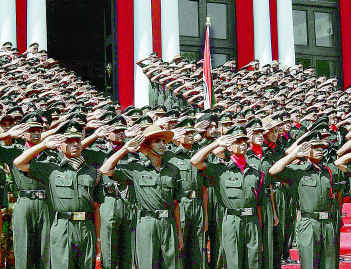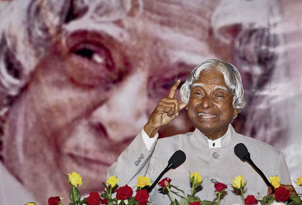 The young and vibrant Chief Minister of Jammu & Kashmir Omar Abdullah is fastly losing his charisma to govern the state. The Sophian tragedy is spilling its bad effect on the capable man and threatens to destroy him politically. It is high time that Omar stops his frequent personal outings, fancy games and time pass activities and concentrate on the governance. This is the last chance given to the promising young man by the people of the state.
The young and vibrant Chief Minister of Jammu & Kashmir Omar Abdullah is fastly losing his charisma to govern the state. The Sophian tragedy is spilling its bad effect on the capable man and threatens to destroy him politically. It is high time that Omar stops his frequent personal outings, fancy games and time pass activities and concentrate on the governance. This is the last chance given to the promising young man by the people of the state.
The Times of India writes (30 July 2009)
The spat between the National Conference and the People’s Democratic Party is a new low for politics in Jammu and Kashmir. In the past few days,
PDP leader Mehbooba Mufti flung a mike at the Speaker of the J&K assembly, a senior PDP leader Muzaffar Hussain Baig randomly accused chief minister Omar Abdullah of involvement in a sex scandal and an indignant CM marched to the governor’s residence with his resignation. All the drama made for less than edifying viewing. Both Omar and Mehbooba must share the blame for enacting the low farce.
Abdullah has since climbed down from the moral high ground, while PDP leaders have agreed to function as a constructive opposition in the legislative assembly. Both parties must stick to their words. Hopefully, better sense will prevail on Mehbooba who seems oblivious of the promise her party leaders made on prime-time television that they’ll not create petty disputes. She was at her aggressive worst on Wednesday, disrupting proceedings in the assembly. Such theatrics are unlikely to help her political career or the PDP in the long run. Similarly, Omar’s impulsive gesture to quit on moral grounds was an irresponsible act. Political instability is the last thing that J&K can afford at this time. Leaders must handle criticism even vitriolic allegations without losing their cool.
J&K politicians must realise that they are at a historic juncture. People have in recent times ignored boycott calls from separatist groups and diktats from militants, in order to vote in elections with the hope that a representative government is best placed to tackle civic issues and other matters of governance. But the performance of the elected representatives in the assembly makes a mockery of their trust in parliamentary democracy. It amounts to betrayal of the hopes of a people who have lived through unimaginable violence for more than two decades.
The preference among mainstream parties for histrionics at the cost of statecraft may be a reflection of Kashmir’s political culture. Theatrics and exaggeration have been an integral part of political activity in the state since militancy broke out in the late 1980s. Measured political articulation may have become impossible in a climate of fear. However, that situation is slowly changing. Reasonably high turnouts in successive elections signal the shift in the political ground. Mainstream politicians, beneficiaries of the turnaround, must reflect the new situation in the state and adopt a language that is constructive and suitable for governance. They must not mess up their mandate by indulging in silly spats and mindless allegations. Don’t let go of a historic opportunity.
 Without the contribution of the private sector India may not have scaled such a height in the education sector. Earlier schools, colleges and universities were run by public charity minded private people. Today most of them want to open an education institution to mint millions of rupees. No problem if they charge high, give good quality education, pay the staff well and impact the student’s lives. Alas! these are not happening. But only money gets poured into their coffers. The country needs to put an end into this menace and reform the education system. The education tribunal should speed up the hearings and bring justice to the exploited students and parents. The quality assessment should be rigorous and the government should weed out the inferior ones quickly.
Without the contribution of the private sector India may not have scaled such a height in the education sector. Earlier schools, colleges and universities were run by public charity minded private people. Today most of them want to open an education institution to mint millions of rupees. No problem if they charge high, give good quality education, pay the staff well and impact the student’s lives. Alas! these are not happening. But only money gets poured into their coffers. The country needs to put an end into this menace and reform the education system. The education tribunal should speed up the hearings and bring justice to the exploited students and parents. The quality assessment should be rigorous and the government should weed out the inferior ones quickly. Social networking is good and bad. Good because it connects people across the world and help them to understand other cultures. Mostly the social networking sites connect old friends, lost friends and less number of new friends. Bad because it kills the time and makes onliners unproductive. It is highly the work places restrict the social networking for the better health conditions and work productivity of its employees.
Social networking is good and bad. Good because it connects people across the world and help them to understand other cultures. Mostly the social networking sites connect old friends, lost friends and less number of new friends. Bad because it kills the time and makes onliners unproductive. It is highly the work places restrict the social networking for the better health conditions and work productivity of its employees. The achievement is no small. Finally India had developed indigenous nuclear submarine. The INS Arihant launched from Vishakapattinam has made Indians proud. I join the entire community of Indians all over the world to congratulate the team which worked night and day to achieve this great feet. Keep conquering India!
The achievement is no small. Finally India had developed indigenous nuclear submarine. The INS Arihant launched from Vishakapattinam has made Indians proud. I join the entire community of Indians all over the world to congratulate the team which worked night and day to achieve this great feet. Keep conquering India!
 and tenders tailored to suit certain bids have all played a role in compromising the armed forces’ readiness and capabilities. It plays into another problem the CAG report highlights; a lack of foresight and long-term planning that has crippled the armed forces. There is no clear vision of where the armed forces must be by 2025 or 2030, or quantifiable waypoints to measure progress towards achieving that goal. This lack of forward planning has plagued India for decades. In the years since independence, various administrative and policy structures have been implemented, from five-year defence plans to an Integrated Defence Headquarters. None of them have been truly successful.
and tenders tailored to suit certain bids have all played a role in compromising the armed forces’ readiness and capabilities. It plays into another problem the CAG report highlights; a lack of foresight and long-term planning that has crippled the armed forces. There is no clear vision of where the armed forces must be by 2025 or 2030, or quantifiable waypoints to measure progress towards achieving that goal. This lack of forward planning has plagued India for decades. In the years since independence, various administrative and policy structures have been implemented, from five-year defence plans to an Integrated Defence Headquarters. None of them have been truly successful.

 progress. This will facilitatate the mutual growth of ASEAN countries. Especially those who are affected by closed mindset will be benefited.
progress. This will facilitatate the mutual growth of ASEAN countries. Especially those who are affected by closed mindset will be benefited.
 The western world is hypocritical about the protocols. No frisking for its leaders but top to toe clean check up for the Eastern leaders. It is highly condemnable act that the continental airlines had frisked the people’s president Dr. A. P.J. Abdul Kalam and refused to apologise intitally. After the uproar in parliament and society they have finally apologised. But the high humility filled Kalam down played the act and said “it is minor”.
The western world is hypocritical about the protocols. No frisking for its leaders but top to toe clean check up for the Eastern leaders. It is highly condemnable act that the continental airlines had frisked the people’s president Dr. A. P.J. Abdul Kalam and refused to apologise intitally. After the uproar in parliament and society they have finally apologised. But the high humility filled Kalam down played the act and said “it is minor”.